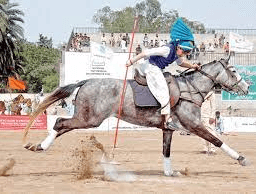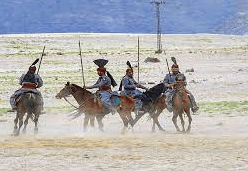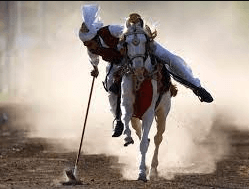Are There Any Safety Measures In Place For Both The Riders And The Horses During Tent Pegging Events?

In the thrilling world of tent pegging events, where riders and horses showcase their skills and bravery, safety measures play a pivotal role in ensuring the well-being of both participants. These measures are not just mere formalities but rather essential precautions that symbolize the commitment to preserving the freedom and integrity of this ancient equestrian sport.
With an objective to provide a comprehensive overview, this article explores the various safety measures in place for both riders and horses during tent pegging events, highlighting the importance of protective gear, training, veterinary care, emergency response, rules and regulations, risk assessment, and continuous improvement.
The first paragraph sets the stage by using symbolism to capture the audience’s attention. Tent pegging events represent more than just a sport; they embody a sense of freedom and honor. By emphasizing their significance as symbols of commitment to preserving these values through safety measures, it appeals to the subconscious desire for freedom that many individuals possess. This approach draws readers in and keeps them interested in learning more about how these safety measures contribute to maintaining this cherished tradition.
The second paragraph introduces the main topics that will be covered throughout the article. It establishes an academic style of writing by presenting an objective overview of what readers can expect from the article. The use of terms such as ‘protective gear,”training,”veterinary care,”emergency response,”rules and regulations,”risk assessment,’and ‘continuous improvement’showcases knowledgeability on the subject matter while portraying a proactive approach towards ensuring safety. By covering these aspects comprehensively, readers gain insight into how organizers prioritize participant well-being at every stage of a tent pegging event.
Importance of Safety in Tent Pegging Events
Ensuring the safety of both riders and horses is of paramount importance in tent pegging events, as it not only protects the participants but also upholds the integrity and credibility of the sport.
Safety measures are put in place to minimize the risk of injuries to both riders and horses during these events.
Protective measures for spectators are also implemented to ensure their safety.
Officials play a crucial role in ensuring safety by enforcing rules and regulations, conducting thorough inspections of equipment, and monitoring the execution of maneuvers.
They are responsible for identifying any potential hazards or risks that may arise during the event and taking appropriate action to mitigate them.
By prioritizing safety, tent pegging events can provide an exhilarating experience for participants while maintaining a secure environment for everyone involved.
Protective Gear for Riders
In order to ensure the safety of riders participating in tent pegging events, it is crucial for them to wear appropriate protective gear.
One key component of this gear is helmets, which provide essential head protection in case of falls or accidents.
Additionally, body armor plays a vital role in safeguarding the riders’ bodies from potential injuries during the rigorous and high-speed maneuvers involved in tent pegging.
These safety measures not only mitigate risks but also promote a proactive approach towards preventing accidents and ensuring the well-being of both the riders and their horses.
Helmets for Head Protection
Helmets provide essential head protection for both riders and horses during tent pegging events. They play a crucial role in head injury prevention and overall equestrian safety. Here are four key reasons why helmets are important in ensuring the well-being of riders and horses:
- Impact Protection: Helmets are designed to absorb and distribute the force of an impact, reducing the risk of severe head injuries. In a fast-paced sport like tent pegging, where riders gallop at high speeds while performing intricate maneuvers, the potential for falls or collisions is inherent. Wearing helmets can significantly mitigate the effects of such accidents.
- Brain Safety: The brain is one of the most vital organs in our bodies, responsible for controlling every aspect of our physical and cognitive functions. A traumatic brain injury can have life-altering consequences. Helmets provide a protective barrier that helps safeguard against direct blows to the head, minimizing the risk of brain trauma during tent pegging events.
- Confidence Boost: Feeling safe and secure is paramount when participating in any sport. By wearing helmets, both riders and horses can gain confidence knowing they have taken proactive measures to reduce potential harm. This increased confidence allows them to focus on their performance without unnecessary distractions or concerns about their safety.
- Setting a Good Example: Encouraging helmet use sets a positive example for others within the equestrian community and beyond. It promotes safety consciousness, emphasizes responsible horsemanship practices, and fosters a culture that values protecting oneself from preventable injuries.
By prioritizing head protection through helmet use, tent pegging participants demonstrate their commitment to equestrian safety while enhancing their overall enjoyment of this exhilarating sport.
Body Armor for Body Protection
Body armor serves as a vital protective gear for participants in tent pegging, offering an additional layer of defense against potential injuries.
The use of body armor technology has advanced significantly in recent years, providing riders with enhanced protection and impact resistance.
Modern body armor is designed to distribute the force of impacts across a larger surface area, reducing the risk of serious injuries.
It incorporates innovative materials such as Kevlar and carbon fiber, which are lightweight yet highly durable.
These materials can withstand high levels of impact without compromising the rider’s mobility or comfort.
Additionally, body armor is often adjustable to fit different body sizes and shapes, ensuring a snug and secure fit for each rider.
Overall, the incorporation of advanced body armor technology in tent pegging events plays a crucial role in safeguarding the well-being of both riders and horses by minimizing the potential risks associated with this equestrian sport.
Protective Measures for Horses
When it comes to ensuring the safety and well-being of horses during tent pegging events, there are certain protective measures in place.
One such measure is the use of leg wraps for injury prevention. These leg wraps provide support and protection to the horse’s legs, reducing the risk of injuries caused by impact or strain.
Additionally, organizers also ensure a safe ground environment by carefully inspecting and preparing the arena surface, minimizing any potential hazards that could pose a risk to both riders and horses.
Leg Wraps for Injury Prevention
Leg wraps are commonly used in tent pegging events to prevent injuries to the horses’ legs. These leg wraps, also known as horse boots, serve as a protective barrier between the horse’s delicate legs and any potential hazards or impacts that may occur during the event.
They are designed to provide support and cushioning to the tendons and ligaments, reducing the risk of strains or sprains. Additionally, leg wraps can help prevent abrasions or lacerations caused by contact with the pegs or other objects on the ground.
To ensure maximum effectiveness, it is important for riders to use proper technique when applying leg wraps. This includes ensuring a snug but not overly tight fit, avoiding wrinkles or folds in the wrap, and regularly inspecting and readjusting them throughout the event if necessary.
By incorporating these safety measures and utilizing leg wraps correctly, riders can help protect their horses from unnecessary injuries during tent pegging events.
Ensuring a Safe Ground Environment
Ground preparation and risk assessment are crucial factors in ensuring a safe environment for both the riders and horses during tent pegging events. The ground upon which these events take place must be meticulously prepared to minimize any potential hazards that could pose a threat to the safety of the participants.
Risk assessment involves identifying and evaluating potential risks, such as uneven terrain, loose soil, or hidden obstacles, that could potentially cause accidents or injuries. To mitigate these risks, organizers of tent pegging events often conduct thorough inspections of the venue prior to the competition and take necessary measures to rectify any identified issues. They may level out uneven surfaces, remove debris or rocks from the area, and ensure proper drainage to prevent waterlogging.
Additionally, specific attention is paid to maintaining suitable footing conditions for the horses by regularly monitoring soil moisture levels and making adjustments accordingly.
By prioritizing ground preparation and conducting comprehensive risk assessments, event organizers demonstrate their commitment to creating an environment that promotes safety and minimizes potential risks during tent pegging competitions.
Training and Skill Development for Riders
One key aspect of tent pegging events involves the honing of riders’ skills and expertise through rigorous training programs. This ensures that they are well-prepared to handle the various challenges that may arise during the event.
Here are three important elements of rider preparation and equestrian techniques in tent pegging:
- Skill Development: Riders undergo extensive training to develop their riding skills, including balance, coordination, and control over their horses. They practice various maneuvers such as picking up and spearing targets, galloping at high speeds while maintaining stability, and executing precise turns.
- Weapon Mastery: Tent pegging requires riders to wield lances or swords with precision and accuracy. They receive specialized training in using these weapons effectively while mounted on a moving horse. This involves practicing accurate strikes at different target heights, controlling the weapon’s trajectory, and ensuring its safe handling throughout the event.
- Horse Selection and Training: Riders work closely with their horses to establish trust and a strong partnership. They learn how to select suitable horses for tent pegging based on factors such as speed, agility, responsiveness, and temperament. Furthermore, they train their horses extensively in specific techniques required for tent pegging events such as quick starts from a standstill position or maneuvering around obstacles.
By focusing on these aspects of rider preparation and equestrian techniques, tent pegging events ensure that both the riders and horses are equipped with the necessary skills to perform safely during competitions while showcasing their freedom of movement in an engaging manner for spectators.
Veterinary Care for Horses
Continuing with the discussion on safety measures in tent pegging events, another crucial aspect to consider is the veterinary care provided for the horses.
Regular veterinary check-ups and equine healthcare are essential to ensure the well-being of these magnificent animals.
Proper medical attention helps identify any underlying health issues and prevents them from worsening during rigorous training and participation in events.
Veterinarians play a significant role in monitoring the overall health of the horses, ensuring that they are fit to participate in competitions.
They provide vaccinations, perform routine check-ups, and offer advice on nutrition and exercise regimens tailored to meet the specific needs of each horse.
By prioritizing equine healthcare, organizers demonstrate their commitment to preserving the welfare of these athletes, further enhancing safety measures for both riders and horses during tent pegging events.
Emergency Response and Medical Support
To ensure the well-being of participants in tent pegging events, it is crucial to establish a comprehensive emergency response system and provide adequate medical support.
In the event of an emergency or injury, having a well-coordinated emergency response plan is essential. This includes having trained medical personnel on-site who can assess and treat injuries promptly. Additionally, there should be clear protocols in place for communication and transportation to nearby medical facilities if further treatment is required.
It is also important to have appropriate medical equipment readily available, such as first aid kits and ambulances, to provide immediate care when needed.
By implementing these measures, organizers can ensure that prompt medical attention is provided in the case of any accidents or emergencies during tent pegging events.
Rules and Regulations for Safe Participation
The establishment of clear rules and regulations is vital for ensuring the safety and well-being of all participants involved in tent pegging competitions.
These rules serve as a framework to minimize risks and create a safe environment for both riders and horses.
One key aspect is the implementation of thorough risk assessments, which identify potential hazards and determine appropriate measures to mitigate them.
This includes evaluating the condition of the ground, assessing the suitability of equipment, and considering factors such as weather conditions.
Additionally, strict guidelines are in place to ensure skill development among participants.
Competitors must demonstrate proficiency in various riding techniques before being allowed to participate in events, thereby reducing the likelihood of accidents caused by lack of experience or inadequate training.
By establishing these rules and regulations, organizers prioritize safety while still allowing participants the freedom to engage passionately in this exhilarating sport.
Risk Assessment and Management
One crucial element of ensuring the safety and well-being of participants in tent pegging competitions is conducting thorough risk assessments, akin to a skilled surgeon meticulously examining every aspect of a patient’s body before an operation.
Risk assessment involves identifying potential hazards and evaluating the likelihood and severity of any associated risks. In the context of tent pegging, this could include assessing factors such as rider competency, horse health and fitness, equipment quality, course layout, weather conditions, and crowd control measures.
Safety management strategies are then developed based on these assessments to minimize or eliminate identified risks. These strategies may include implementing strict guidelines for participant eligibility and training requirements, enforcing horse welfare regulations during competitions, regularly inspecting equipment for damage or wear, monitoring weather forecasts for adverse conditions that could affect the event’s safety, and ensuring adequate medical personnel are present at all times.
By utilizing comprehensive risk assessment techniques and implementing proactive safety management practices, organizers can strive to create a safe environment where riders can showcase their skills while minimizing potential harm or injury to both themselves and their horses.
Continuous Improvement in Safety Standards
Continuous improvement in safety standards is crucial for enhancing the overall experience and minimizing potential risks in tent pegging competitions.
The welfare of horses is a top priority, and measures are constantly being implemented to ensure their well-being during these events. For instance, strict regulations are enforced regarding the use of equipment such as bits and saddles to prevent any unnecessary discomfort or injury to the animals.
Additionally, regular veterinary check-ups are conducted before and after each competition to assess the health of the horses and address any issues promptly.
Furthermore, training programs are provided to riders to enhance their skills and knowledge on horse handling techniques, thereby reducing accidents caused by human error.
Moreover, continuous research and development efforts aim at introducing innovative safety technologies that can further safeguard both riders and horses during tent pegging events.
By striving for continuous improvement in safety standards with a focus on improving horse welfare and reducing accidents, organizers not only prioritize the well-being of these magnificent creatures but also ensure a safer environment for all participants involved in this exhilarating sport.
Frequently Asked Questions
Are there any rules and regulations in place to ensure the safety of both riders and horses during tent pegging events?
Spectator safety is of utmost importance during tent pegging events. Weather conditions can greatly impact the safety of riders and horses, making it crucial to implement rules and regulations ensuring their well-being.
What type of protective gear do riders need to wear during tent pegging events?
Riders participating in tent pegging events are required to wear protective gear to ensure their safety. This includes helmets, body protectors, gloves, and sturdy footwear. These measures aim to minimize the risk of injuries during the sport.
How are horses protected and cared for during tent pegging events?
Horse welfare and equine health are of utmost importance during tent pegging events. Measures such as regular veterinary checks, proper nutrition, and appropriate training techniques ensure the well-being and safety of the horses involved in these competitions.
Is there any specific training or skill development required for riders to participate in tent pegging events?
Riders participating in tent pegging events must possess specific qualifications and undergo rigorous training. They develop skills such as precision, balance, and timing through techniques like obstacle courses and target practice. A visual representation of their dedication is akin to a tightly woven tapestry of expertise.
What emergency response and medical support are available in case of accidents or injuries during tent pegging events?
In case of accidents or injuries during tent pegging events, there are emergency response teams and medical professionals on-site. They provide immediate assistance and necessary medical support to ensure the well-being of riders and horses.
Conclusion
In conclusion, safety measures play a crucial role in ensuring the well-being of both riders and horses during tent pegging events. The implementation of protective gear for riders, such as helmets, body protectors, and appropriate footwear, is imperative to mitigate the risk of injuries. Likewise, adopting protective measures for horses, including leg wraps and hoof boots, helps safeguard them from potential harm.
Moreover, training and skill development programs for riders are vital to enhance their knowledge and expertise in handling horses during these events. This not only reduces the chances of accidents but also promotes better understanding between the rider and horse. Additionally, regular veterinary care ensures that horses are healthy and fit to participate in tent pegging competitions.
Furthermore, having an emergency response plan in place along with immediate access to medical support is essential to address any unforeseen situations promptly. Adhering to rules and regulations set by governing bodies guarantees safe participation by all involved parties. Regular risk assessment enables organizers to identify potential hazards proactively while implementing necessary measures for risk management.
In conclusion, safety should always remain a top priority in tent pegging events through continuous improvement in safety standards. By maintaining a detail-oriented approach towards safety measures concerning both riders and horses alike, organizers can create an environment where participants can compete with confidence while minimizing any risks involved.
Just like a well-choreographed dance routine ensures smooth movements without stepping on each other’s toes; implementing comprehensive safety protocols creates harmony between the various elements of tent pegging events while ensuring the welfare of everyone involved.



